Mark Hunter's Blog, page 15
March 22, 2023
10 Rules of the Prospecting Game
There are some basic rules you need to get right. To win at prospecting, here are my Top 10 insights to the game.
1. Prospects don’t care.Until you show an interest in them, there’s no reason for them to show an interest in you.
If you’re prospecting by just throwing messages out there, nobody’s going to respond.
2. Thinking about a prospect is not prospecting.Learn more about What Prospects Want to Hear.
An average performer could spend all day getting ready to prospect, doing research, but they never actually pick up the phone and make the call.
Prospecting requires action. Just pick up the phone.

via Kim’s Convenience on GIPHY3. Repetition wins the game.
One call or one email isn’t going to do a thing. It requires repetition. However, you must make sure that your messages are different. Just sending the same message out time and time again is not going to do anything.
Repetition of the same thing will get you the same thing—no results.
4. Know your market.
Who are you calling? Who are you reaching out to? This is so critically important.
What do you know about their industry? Their demographics? You’ve got to understand that because, again, prospects don’t care about you until you’ve shown an interest in them.
5. Be disciplined.
It is so easy to fall off the bandwagon with prospecting. There are a dozen things fighting for your attention.
Discipline is the single biggest reason why some people make it prospecting and others don’t.
 6. Follow up.
6. Follow up.You may get one conversation with a prospect and you think, wow, this is going to become my next great customer. Then you never hear from them again.
You’ve got to create follow-up messages that are tuned to their needs, not about what you have to sell.
This is such an important skill we have two masterclasses for your at The Sales Hunter University:
+Learn about cultivating two-way communication with the Follow-Up Masterclass.
+Or, master the art of continuous conversation with the Stop Getting Ghosted Masterclass.
7. Powerful CTAs, calls to action.
Every message you send has got to have a call to action. Don’t leave customers hanging, make the decision for them. You have to get them involved with you, and you do that with a CTA.

via GIPHY8. Your mindset.
If you don’t have the right mindset, you can go through all the actions you want, and you won’t see any results at all. I guarantee it, because your customers, your prospects will see through that.
Your mindset will defeat you if it’s not right. What is the right mindset? To go out there and make a difference because prospecting is about helping others see and achieve what they didn’t think was possible. Anchor your mindset on that.
Likewise, if you know you can make a difference in somebody’s life, you have an obligation to reach out to them. Let those two pieces sink into your mind, and it’ll make a difference in how you prospect.
9. Focus on the outcomes, not the product.The customers don’t want your product. They don’t want your service. What they are looking for are solutions.

via The Daily Show on GIPHY10. Your personality.
You have to let your personality come through. This is not a robot situation. You have to allow the customer to see who you are. In fact, when you let your personality come through, it’s amazing how much more relaxed you are.
 Available NOW!How to Sell to the CEOLearn Mark’s Top 16 Tips for reaching the CEO and speaking their language.
Available NOW!How to Sell to the CEOLearn Mark’s Top 16 Tips for reaching the CEO and speaking their language.
Find it anywhere you stream podcasts.
COMING THURSDAY 3/23!How Serving Brings Success in Salesw/ Bob Burg
How do we bring immense value through giving?
Subscribe today and gain weekly sales insights!
 Join us in-person in Dallas, TX or online!
Join us in-person in Dallas, TX or online!Learn inside sales secrets developed by Mark and Meridith and start achieving results beyond your expectations!
Learn more or register at this link.
Copyright 2023, Mark Hunter “The Sales Hunter” Sales Motivation Blog. Mark Hunter is the author of A Mind for Sales and High-Profit Prospecting: Powerful Strategies to Find the Best Leads and Drive Breakthrough Sales Results .
The post 10 Rules of the Prospecting Game first appeared on The Sales Hunter.
March 20, 2023
How to Sell to the CEO
CEO Facts1. CEO’s don’t have budgets.
They set them…and take them. Don’t ever think that there’s no money. There almost always is money, and they will spend it because they don’t have budgets.
2. CEO’s want strategic answers.They don’t buy stuff, they have others that do that. If you’re selling them something, they’re going to send you to Purchasing.
Your questions have to be wrapper around strategic topics. The way you speak to a CEO cannot be the same way you speak to a lower-level manager. Often, they don’t need the details, they need the bigger picture.
3. CEO’s don’t trust anyone who is not referred to them.Think “tranferrable trust”. You need someone else to introduce you to the CEO and make a connection. If that someone else is trusted by the CEO, they’ll automatically think that you are someone they can trust.

via Law & Order on GIPHY4. CEO’s are outcome focused.
They’re not about the mechanics of how something works. That’s for somebody else to worry about.
If you want to go into a conversation with a CEO and want to explain how your product works—they don’t care. What they want are outcomes.
5. CEO’s value time.Brevity wins the day. Don’t keep the meeting going just because you have scheduled time.
Make it brief, the CEO will appreciate that.
6. CEO’s delegate.Manage your time like a CEO. Read these 5 time tips.
They are always looking for a way to get something off of their plate.
If it can reduce their time, they’re interested. That includes the meeting with you! If you don’t give them a reason to meet you and preset the value of that meeting, they’ll likely cancel.

via ION on GIPHY7. Integrity matters
The CEO is a pretty lonely position. This is why they want somebody they can trust and respect.
That’s why they often need someone else they trust and respect to carry you into the c-suite.
How to Reach the CEO1.Transferrable trust, a peer relationship
If you can develop relationships with other people who know CEO’s, that’s going. tobe incredibly powerful for you to open doors.
2.Industry association/eventReferrals are a huge asset. Enroll in the Referrals Masterclass and learn how to get more… consistently.
CEO’s are often in leading positions in a trade association, so you need to be involved too.
Or perhaps they don’t have an active role, but one of their direct reports or senior lieutenants does. You want to know those people as well.

via maddyshine on GIPHY3.Company peer or highly regarded direct report
The CEO might be part of a larger organization that owns other companies, other divisions. Are there people you know in those who could help carry you in?
Some CEO’s could have 7-12 direct reports. Among them there could be 2-3 that they really respect. Identify those people, and have them take you to the CEO.
4. GatekeeperIt’s a two-step process; you have to earn their trust first. Let them see how you’re going to bring value so they see you warrant the CEO’s attention.
Final Insights into the C-Suite1. Be seen as a person on their level.
You have to be seen as a peer. You have to do your homework and know their business, their industry, even a little about them before you begin. Then you can ask the right strategic questions.
Do your homework before the meeting, not on the sales call.
2. You do not reach the CEO flying solo.You have to be carried into the C-Suite. That requires a peer relationship.
Because CEO’s can be skeptical, they’re jaded, and they aren’t going to accept input from anybody they don’t trust.

via TV Land on GIPHY3. Establish your position in the marketplace.
Your reputation goes before you. Nobody has a meeting with anybody without checking them out online. CEO’s are likely to do a deep dive.
So you need to make sure your online reptuation in the marketplace is zeroed in on the industry and what it is you do.
4.Be prepared to go big.How does your LinkedIn profile showcase you? Read these 10 tips for success on LinkedIn.
Invest! You may have to jump on an airplane in order to have a meal with them. Or you might have to travel all day just to attend a one-hour breakout session or industry event with hopes of rubbing shoulders with the CEO.
5.Play the long-game.Cracking the c-suite will not happen overnight.

via GIPHY News on GIPHY
 Leave us a rating/review today!
Leave us a rating/review today!For more insights and content like this, subscribe to The Sales Hunter Podcast on your favorite podcast app.
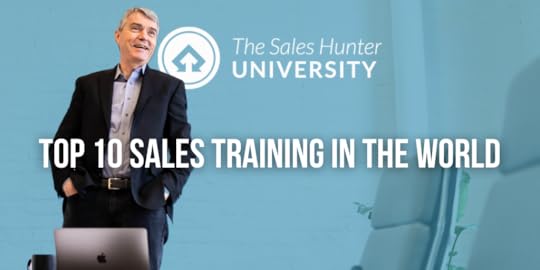 Keep your sales skills sharp by becoming a student of The Sales Hunter University.
Keep your sales skills sharp by becoming a student of The Sales Hunter University.Masterclass courses available now!
Click the images to learn more about each course!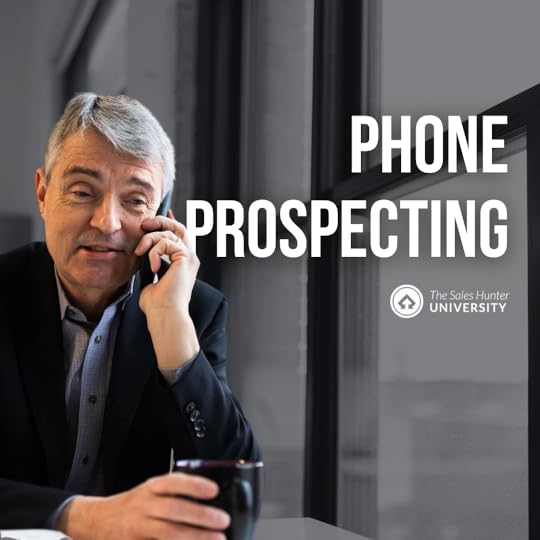




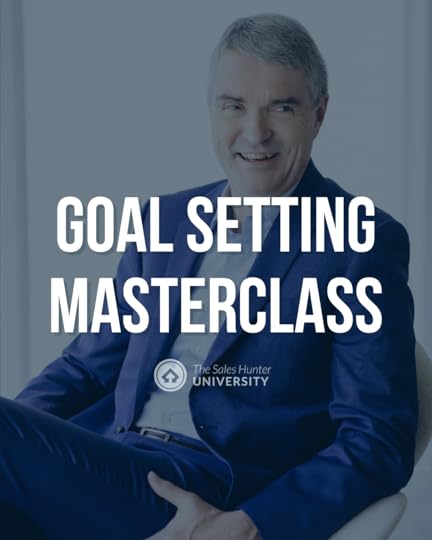
Copyright 2023, Mark Hunter “The Sales Hunter” Sales Motivation Blog. Mark Hunter is the author of A Mind for Sales and High-Profit Prospecting: Powerful Strategies to Find the Best Leads and Drive Breakthrough Sales Results .
The post How to Sell to the CEO first appeared on The Sales Hunter.
March 15, 2023
How to Build a Sales Pipeline
Build your sales pipeline in a way that deals flow through with ease from top to bottom.
How? I’ve got 10 tips for how to build a healthy sales pipeline.
1. Know your solution.Know how you (your product, your service) help people. If you don’t know your solution, then why are you putting together a sales pipeline?
2. Know your ICP, Ideal Customer Profile.Knowing your perfect customer upfront is absolutely key. This is going to help you determine what goes into your pipeline.
3. Know how to bring value.Discover and develop your own ICP with the Ideal Customer Profile Masterclass.
What are the questions that you need to be asking?
Are there studies that you share that customers normally like, (or whatever it might be)?
How does this value turn into outcomes that customers get after they buy from you?
4. Build your cadence.You can begin to build your cadence based on the answers to the questions above.
How many times do I have to send them emails, mail, or a text to turn them into a customer? I need a cadence that I can administer multiple times to many, many people at the same time. So, as you build out your cadence, don’t build it so complicated that you can only handle one prospect at a time. That’s not a cadence.
5. Create your questions and talking points.Read these 10 Steps to a Great Prospecting Cadence
We spend so much time developing the information we want to share and not enough time spent on the questions we ask. In my cadence, my messages, my conversations, in everything I communicate, what are the questions I’m going to ask? What are my talking points?
My absolute objective is to be able to have this platform of information that I’m so comfortable asking and talking about at any time with any prospect that it becomes a routine.
 6. Establish a routine.
6. Establish a routine.I can establish a routine that I can repeat over, and over, and over again. If you don’t have a routine, it’s just not going to work because there are too many activities involved to be successful.
Organization of a routine brings a method to madness.
7. Leverage your CRM.Don’t think you can get by without a CRM. Of course, you don’t have to have a complex CRM. The top of the food chain is Salesforce and Dynamics, for instance. If you’re a small business, you really don’t need those. You can get by with Zoho, or any number of more simple CRMs.
8. Know your CTAs, call to actions.As you’re asking questions, or going through your cadence, what are your call to actions going to be? You need to make sure that you have one for each message you send out.
9. Build your schedule.This builds off of your ever-important routine.
What’s your schedule going to look like Monday through Friday? I realize no two days are ever alike, but you’ve still got to have routines.
Routines ensure you follow up enough times with these prospects as you work to understand who stays in your pipeline and who comes out. (You have to be willing to take things out of your pipeline just as much as you are putting things in.)
10. Execute the plan.This means continuously reviewing my pipeline because I don’t want a sewer pipe. A sewer pipeline is where I have all these names and all this stuff in there, and I just don’t know what to do with them.
I want to have a water tap that I’m putting prospects in. The questions I can ask have been prepared and practiced. I know the solution I can help them with. They fit my ICP. I know how I can bring value, and I can move them through quickly. That’s executing.
Listen to the 6-minute episode of The Sales Hunter Podcast for more on this topic: Ep. 79. Is Your Sales Pipeline a Sewer Line or a Water Tap?
 Join Meridith and Mark for Sales Logic LIVE!
Join Meridith and Mark for Sales Logic LIVE!
Your ability to have your best year is achievable by attending Sales Logic LIVE, where you’ll learn the inside sales secrets developed by Mark Hunter and Meridith Elliott Powell.
Early registration discounts available now!
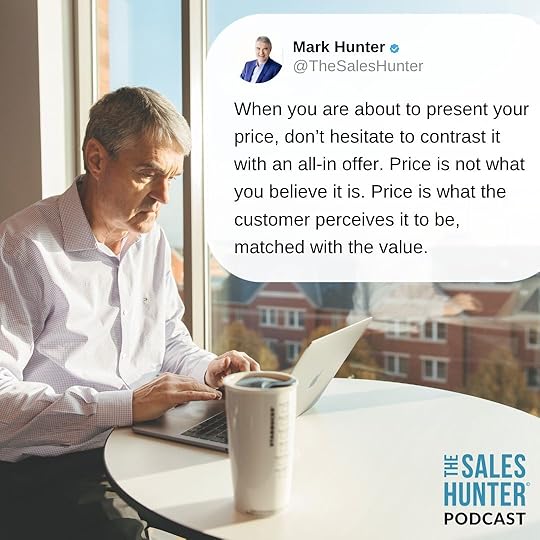 Available now!
Available now!How to Use the Contrast-Anchor Method for Price
How good are you at responding to objections to price?
Find this topic and more on The Sales Hunter Podcast.
Episode 82 Coming Thursday:Building Trust that Brings Big Resultsw/ David HorsagerSales go at the speed of trust.
Subscribe now and never miss an episode!

Copyright 2023, Mark Hunter “The Sales Hunter” Sales Motivation Blog. Mark Hunter is the author of A Mind for Sales and High-Profit Prospecting: Powerful Strategies to Find the Best Leads and Drive Breakthrough Sales Results .
The post How to Build a Sales Pipeline first appeared on The Sales Hunter.
March 8, 2023
10 Reasons Why Salespeople Fail
I’m going to list ten reasons why salespeople fail. Now, it’s not that salespeople fail on all ten of them, but all it takes is one or two.
This post is to help you steer clear of these ten mistakes, because I want you to be successful.

via GIPHY 1. Poor time management
Salespeople who don’t use their time well, or take all day to get going, get knocked out of sales. They spend all their time doing everything except what they’re supposed to be doing.
This not only knocks people out of sales, but out of so many other positions and really achieving the success that’s possible in life.
2. Too product focusedSure, they’ve got all this product knowledge, but that’s all they want to focus on— product knowledge.
Customers don’t want a product. They want solutions. If you’re too product-focused, you’ll never take time to listen to the outcomes that the customer is looking for.
3. Not knowing the customerRead about how Prospecting is an Outcome Game.
Treating every customer as a random email or a random phone call is not going to work. You’re going to become defeated very quickly, and it’s going to get boring.
Take some time to understand who the customer is so you can ask better questions and have better dialogue.

via Yellowstone on GIPHY4. Lack of a repetitive process
You’ve got to be able to do it over and over and over again. Think about things in your life: you get dressed in the morning, you have a very set routine, and it goes smoothly. If you don’t have that routine, it’s amazing how awkward it can be.
Similarly, lack of a repetitive process slows down everything. For example, prospects that you don’t follow up on properly.
5. Failing to use a CRM systemDon’t think that you can do this job without your CRM system or just barely putting in any information at all. Instead, use it to the fullest because it’s there to guide you and help you.
 6. Having a poor mindset
6. Having a poor mindsetHaving a poor mindset defeats anybody. Once you start falling down, you can quickly go into a death spiral.
This is why I say that to help you with a poor mindset, you’ve got to have places like The Sales Hunter that you’re getting insights and knowledge from.
You’ve got to have peers that you can reach out to and connect with that are challenging you, and you’re challenging them. Sales is not a solo activity. Sales is a team sport, and that’s the only way you’re going to make sure that you have a positive mindset.
7. Not believing in the outcomeIf you’re interested in some mindset work, check out the A Mind for Sales Masterclass, or read A Mind for Sales.
You don’t have to believe in your product, but you do have to believe in the outcome. You have to believe in the outcome that you can truly help people see and achieve what they didn’t think was possible.
If you don’t believe in that, then why are you selling? Get out of sales right now.

via Apple TV+ on GIPHY8. Chasing shiny objects
This is like chasing the squirrel. “Wow, this is a cool idea. If I get really good at this, I’ll be really successful in sales.” And then, they spend the next two, three weeks chasing that, and it doesn’t work. Or, “Here’s a great customer. I’m going to go do this. It’s going to be my multimillion dollar deal.” Boom, and it doesn’t work. You’ve got to stay focused.
9. Lack of a positive peer groupI call this out very succinctly because I’ve watched salespeople who do not have a positive peer group, and it’s hard for them to stay in the game.
A rising tide lifts all boats. Who is lifting you up?

via Celine Dion on GIPHY10. Having goals, but no plan.
Anybody can make goals. But what’s your plan to achieve them? If you don’t have a plan to achieve your goals, your goals are just dreams.
 Is Your Sales Pipeline a Sewer Line or a Water Tap?
Is Your Sales Pipeline a Sewer Line or a Water Tap?
Available Now on The Sales Hunter Podcast!
Subscribe today so you never miss amazing sales insights. Coming Thursday 3/9…How to Demonstrate Your Difference in Prospectingwith Simon Hares
How can you discover the unkown, unspoken problem?
Click here to subscribe via your favorite app.

 Set yourself up for success, not failure!
Set yourself up for success, not failure!Enroll in a masterclass today to keep your sales skills sharp.

via GIPHY
-OR- Go all in with an All-Access Membership and get ALL masterclass, ALL training, and ALL the Q&A videos.
Copyright 2023, Mark Hunter “The Sales Hunter” Sales Motivation Blog. Mark Hunter is the author of A Mind for Sales and High-Profit Prospecting: Powerful Strategies to Find the Best Leads and Drive Breakthrough Sales Results .
The post 10 Reasons Why Salespeople Fail first appeared on The Sales Hunter.
March 1, 2023
10 Ways to Get a Prospect to Respond
Wait! You have no idea how valuable of a prospect they are until you have the conversation with them.
Sure, you’ve made four or five calls or emails, and they’re not responding. But you have the ability to help them, so it’s your obligation to reach out to them…you’re in it for the long haul!
How do I get them to engage? Let me share 10 ways to do it.
1. Know the prospect.You’ve got to know something about them—minimally their business or industry. More importantly, you really want to know something about them individually. It’s called the worldwide web, there’s plenty of information out there.
You need to know the prospect if you want them to respond to you.

via Island Records UK on GIPHY2. Be engaging.
It’s not about robotic messages or leaving voicemails. Let them understand who you are and allow your personality to come through.
They don’t have to respond to you, but they will if they see you as an individual that they could spend time with.
3. PeersMaybe you can’t reach the person, but you can reach others in their circle.
I may only get that one prospect to respond when I reach out to other people they’re connected with. These could be people they work with, or other people they know. Use your network!

via Laurène Boglio on GIPHY4. Use every medium.
Just because you like sending emails doesn’t mean the prospect does. They may prefer text messages, social media, or even video messages. You have to use every medium because you don’t know what their preferred communication method is until you break through to them.
Don’t assume that your preferred communication method is their preferred communication method.
5. RepetitionRepetition is not about the same thing. Hi, call me. Hi, call me. Hi, call me.
Every message you send has to be different, but you’ve got to be able to repeat the process.
And repeating the process doesn’t mean you’re going to reach out to them once every six months. There has to be a deliberate cadence so they can begin tying your contacts together.
Read these 10 Steps to a Great Prospecting Cadence.
 6. Be the industry leader.
6. Be the industry leader.Of course they’ll be much more likely to respond to you if they know you as an industry leader. “Oh wow, I know that person because I’ve seen them. I’ve read some of their stuff that they’ve put out on LinkedIn”… or wherever it might be.
Your prospect will always Google you before they reach out to you. It’s amazing how that opens up doors ahead of you. By being the industry leader, you’ve got to ensure that Google puts a good impression of you in front of them when they look.

via Disney Channel on GIPHY7. Make it easy
Don’t make it complicated for the person to engage with you. This is where you have to own the space and take ownership. If the prospect responds to you on Friday at 4:30 p.m., you call them back at 4:32 p.m. If they reach out to you on a Saturday, you reach back out to them.
Avoid “Hey, I can be available next Tuesday,” or if you use an automated calendar function, you only have open times three, four weeks out.
You have to make it easy for them to do business with you.
8. Use studies and infographicsYou can send them a study, or an infographic because you want to be seen as a leader.
When the prospect sees that you have enough insight and enough information that they can benefit from, they will take your call, or even reach out to you.
9. ManagementMaybe the dialogue starts with somebody else!
Let’s say you can’t get the meeting with them, but your manager or your CEO, COO can get a meeting with somebody else in that company.
The same goes for your prospect’s company. There are other people in the company that you should be reaching out to. Don’t hesitate. You don’t have a relationship yet with this person, so you have nothing to lose by reaching out and contacting other people further up the chain.
10. Industry eventsThere are always industry events happening, whether it be a trade show, a conference or just an association website.
Use those, because when people can begin to connect you to their industry, they begin to see you as a peer to respect and listen to.

via The Tonight Show Starring Jimmy Fallon on GIPHY
 How Top Performers Sell at Full PriceYour price reflects your confidence.5 Quick Tips on how to prospect better and discount less. Welcome Tony Morris to the podcast!Serial sellers listen to learn…and they ask intelligent questions.
How Top Performers Sell at Full PriceYour price reflects your confidence.5 Quick Tips on how to prospect better and discount less. Welcome Tony Morris to the podcast!Serial sellers listen to learn…and they ask intelligent questions.
LIVE Thursday, 3/2! Subscribe to never miss an episode.

 Top performers never stop learning.Which sales skill will you perfect this year?
Top performers never stop learning.Which sales skill will you perfect this year?
Take a masterclass in Email Prospecting, Pricing, or Follow-Up. See these and a dozen more at The Sales Hunter University.
Want them all? Save money by becoming an All Access member.
All Access includes:
all masterclassesworkshopsa sales vault of training videos!
Copyright 2023, Mark Hunter “The Sales Hunter” Sales Motivation Blog. Mark Hunter is the author of A Mind for Sales and High-Profit Prospecting: Powerful Strategies to Find the Best Leads and Drive Breakthrough Sales Results .
The post 10 Ways to Get a Prospect to Respond first appeared on The Sales Hunter.
February 22, 2023
10 Ways to Use ChatGPT in Sales
But you’ve got to understand how to use it.
My co-host Meridith Elliott Powell and I dove into this topic on a recent episode of Sales Logic, which you can find here.
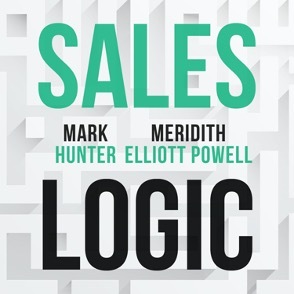
I took it a step further and interviewed expert Ford Saeks on The Sales Hunter Podcast…Listen here.
 After much learning, here’s my take. Let’s start with two warnings. 1. Don’t believe everything
After much learning, here’s my take. Let’s start with two warnings. 1. Don’t believe everythingDon’t believe everything you see, or everything you read. Already we’ve seen enough situations where, for instance, Google launched their version called Bard, it failed miserably, and their stock dropped $100 million in value. In the case of Microsoft, same thing in terms of attaching it to Bing.
You can’t believe everything you see. However, it’s going to get better and better. Still, you’ve got to be careful.
2. Check everything twiceDon’t make assumptions. You’ve got to be careful here because you run the risk if you ask ChatGPT something and you automatically take it to the bank.
Instead, check everything twice.
So, what can I use it for?3. Questions you can askBefore any meeting with a customer, you could ask ChatGPT, “What would be some questions I should ask this customer regarding X?”
Now, the key to getting good information from ChatGPT is to be as specific as possible because it’s going to help you.
Ford Saeks gets into the specific prompts he uses in Episode 74 of The Sales Hunter Podcast…How ChatGPT is Raising the Bar in Sales—available now!
By the way, the reason I said to check twice: it’s amazing how you can get two different answers just minutes apart. I did that the other day. I was asking ChatGPT a very specific question, and I got an answer back. Then I asked the same question about 10 minutes later, and the response was different.
4. Answer your FAQsYou know your business so well, much better than your customers ever will. So here’s the situation: do you really understand and know the questions that customers might ask? Why not ask ChatGPT? It’s going to help give you some answers to some of those FAQs?
You say, “What are the questions customers might ask if they were to buy X product, X service?”
5. Statements to shareI like this because I can use ChatGPT to just give me some quick bullet points around X or around Y.
It’s also very easy to craft social media posts, even blog posts around a topic. Of course, it’s best to treat the response as the bones of your post to then add some meat and make it your own. Consider it inspiration.

Friday, Feb 24th at Noon CT…register now!
6. Prompting ideasYou might be in the middle of developing a presentation, and you’re just stumped. What are the real benefits that customers are going to get? Ask ChatGPT, and it’s going to prompt you with some new ideas.
It may prompt you with some new things that you should explore, some new questions you might want to ask.
7. Uncover new insightsChatGPT can change your perspective because, unlike a Google search, it gives you all the information right there. It’s not about the curiosity factor.
8. Speed the processIf I was working on a customer in an industry I might not be super familiar with, I might have to spend a fair amount of time out on Google to try to get up to speed. Now I can use ChatGPT, and it’s going to bring the information to me. It’s going to allow me to speed up the process.
9. Use it with GoogleYes, you get some information from ChatGPT, and you think it’s good. Then cross check it with Google. What does Google say about it? Go back to some of the sites, and you can ask ChatGPT to share sources with you.
It’s true! Ask it to give you the sources, and it will. You see, the key with ChatGPT is to get as specific as possible.
10. Industry briefingThere’s no better way to really get up to speed on your industry than reading, exploring, and diving into different sites, articles, or books to become an expert.
Well, guess what? I can use ChatGPT to help me become that expert. I’m going to use it as an industry briefing. It’s also going to help me if, “Wow, I got to go into a new area. I don’t know enough about that area.” Boom. Ask ChatGPT.
Do you see how this tool can help you?No, I don’t think ChatGPT is going to replace you. This is no different than when Google Search came around, and Google Search did not replace salespeople. In fact, I think our role in sales and our role to customers is actually increasing because of ChatGPT.
Why? Because the customer is going to be receiving all this information and think they have the answers. They’re going to actually become overeducated, but it’s not all going to be correct, and we’re going to have to de-educate them. Only we as salespeople can deliver the insights, the questions, have the dialogue with the customer.
Only we can do that. Our job is safe.

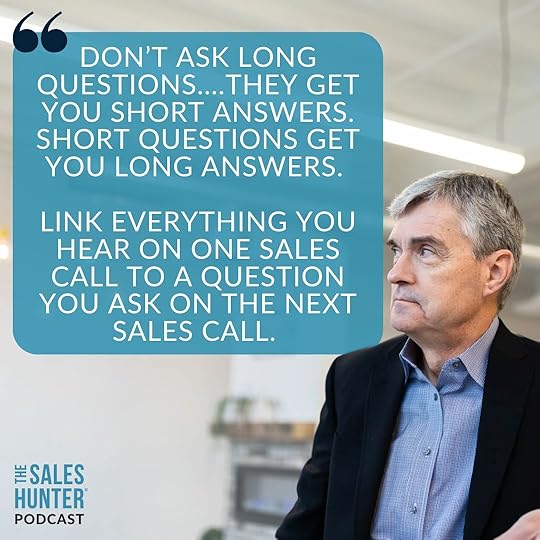
Available Now:
How Top Performers Use Questions to Close More Deals
Available Thursday:
Why Sales Needs More Women w/ Lori Richardson
Click here to subscribe or leave a review!
The Top 1% Playbook is back for Part II!Join us Friday, Feb. 24th at Noon CT In this live interactive workshop I’ll show you things such as:How to refine your sales process to close more deals fasterWhat messaging works and how to use it with customersThe power of leveraging others to help you sell moreHow top performers do it differently and as a result achieve significantly improved results in less time.
In this live interactive workshop I’ll show you things such as:How to refine your sales process to close more deals fasterWhat messaging works and how to use it with customersThe power of leveraging others to help you sell moreHow top performers do it differently and as a result achieve significantly improved results in less time.After the smash success of Part I, you definitely can’t miss out. Register here to attend live or receive the recording.
Copyright 2023, Mark Hunter “The Sales Hunter” Sales Motivation Blog. Mark Hunter is the author of A Mind for Sales and High-Profit Prospecting: Powerful Strategies to Find the Best Leads and Drive Breakthrough Sales Results .
The post 10 Ways to Use ChatGPT in Sales first appeared on The Sales Hunter.
February 15, 2023
Prospecting Is an Outcome Game
A big reason salespeople struggle with prospecting is because they’re too busy selling the product. People don’t want to buy products. They want to buy solutions —they’re looking for outcomes.
1. Know your outcomes—all of them.Be very active in looking at your current customer list— what are the outcomes they achieve?
How did your product or service benefit them? Write all of those outcomes down because that’s what you’re selling. You’re not selling your product. This is going to change your mindset.
Remember, if you have the ability to help someone, it’s your obligation to reach out to them.
2. Build an FAQ for each outcome.This is your playbook. Because for each outcome, I want to have a frequently asked question.
What are the types of questions that I need to ask for them to reveal that’s the outcome they’re looking for?
In contrast, what types of questions will my customer have once we’ve identified their desired outcome?
The FAQ also includes information you want to share. For example, “Hey, here’s how other customers I’ve sold to have been able to make this work.”

via US National Archives on GIPHY3. Build questions to go deep.
But Mark, I’m in the prospecting phase. Actually, the faster I go deep with my questions, the more engaged the customer’s going to be, and the better the outcome is that I’m going to find.
I can’t take surface answers. I’ve got to go deep. When somebody says something, even on a prospecting call, I want to ask them a follow-up question on it. More information from the customer gets us both closer to their desired outcome.
4. The outcome is customer controlled.Watch my latest podcast episode on Suspects or Prospects to learn how to qualify fast and early. Or find it (Ep. 71) wherever you listen to podcasts.
It’s not for you to determine what the customer’s outcome is. The customer will tell you.
Don’t assume anything. This can be where prospecting goes awry, because we think we know what the outcome is, so then we start steering the conversation down a mistaken path.
You have to allow the customer to say what the outcome is and then you build on it. This is why you have the FAQ. This is why you ask questions that go deep. However, I want to make sure that they fully understand it first.
Read these 6 Things Customers Need Before They Buy.
 5. Stay ICP focused.
5. Stay ICP focused. If they throw out an outcome, but it’s an outcome and a customer in an industry you’ve never dealt with, you’re not going to know how to run with it.

via The Lonely Island on GIPHY
For that reason, you need to stay very ICP (Ideal Customer Profile) focused. When I stay in my lane with my ICP, it allows my outcomes to line up better, and it’s going to allow me to be a more sophisticated, intelligent salesperson to help guide the customer through it. Being ICP focused helps me become a subject matter expert.
6. Outcomes vary by position.Workshop your own ICP(s) in my Ideal Customer Profile masterclass, available now.
The frontline person who is actually going to use the piece of equipment is going to have a different outcome than, say, the production manager or the CFO. Understand that outcomes are going to vary by the position, and be prepared for those variances.
Go back to knowing your outcomes, all of them, and building that FAQ. This is so key, because when I hear different things, I need to know how to respond. Of course, people in different positions are going to see things differently.
7. Know the ROI.Remember, nobody buys anything just for the sake of buying something. Every purchase they make is an investment and they’re looking for a return.
In other words, if this outcome is going to help you reduce labor or help you achieve this goal, how do I begin to think about that from an ROI?
Knowing the ROI helps me gain more confidence in what I’m selling, and helps me to position my solution to fit your needs.
8. Tie to the calendar.People have a lot of outcomes they’re looking for, but unless they’re urgent, they’re just not going to run with it.
The more I can create (real, not fake) urgency, the better off I am. Customers today are only dealing with their number one or number two priorities. Even in my own company, we have a lot of things we want to work on, but we’re focused on our top one or two priorities.

via General Hospital on GIPHY9. Link to customer priorities.
This is why I’ve got to do enough investigating, asking questions, because I’ve got to understand: where does this fall in their list of priorities?
I have this happen all the time where customers aren’t ready to pull the trigger. They aren’t ready to buy because the priority is further down on their list.
10. Sell the outcome.The product or service that you’re selling is just a medium to help the customer achieve the outcome. Stay 100% focused on the outcome.
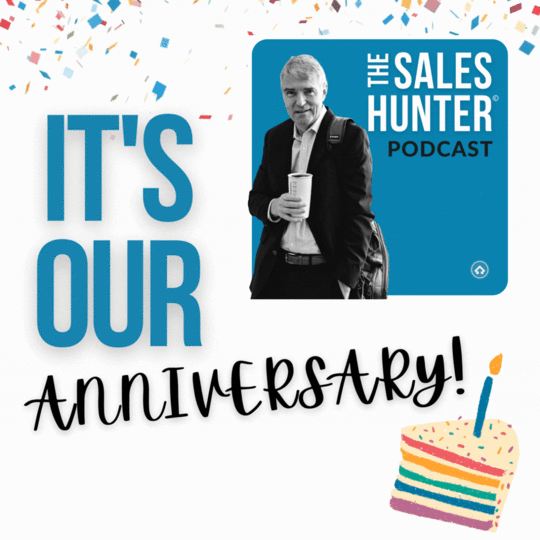 Curious which episodes made our Top 10 List?
Curious which episodes made our Top 10 List? Our very special anniversary episode is out now!
Stream anywhere you listen to podcasts.
 ChatGPT will replace people…if they’re not using AI.We welcome Ford Saeks to Thursday’s episode for an awesome conversation.
ChatGPT will replace people…if they’re not using AI.We welcome Ford Saeks to Thursday’s episode for an awesome conversation.Subscribe today so you never miss a thing!
Copyright 2023, Mark Hunter “The Sales Hunter” Sales Motivation Blog. Mark Hunter is the author of A Mind for Sales and High-Profit Prospecting: Powerful Strategies to Find the Best Leads and Drive Breakthrough Sales Results .
The post Prospecting Is an Outcome Game first appeared on The Sales Hunter.
February 8, 2023
Prospecting Is an Activity Game
Prospecting is a lot like a gym membership. You can’t get a membership to the gym and expect to be in shape. You’ve got to go and work the machines, put in the reps, spend the time.
Last week I shared how Prospecting Is a Mental Game…let’s look at 10 ways prospecting is all about your activities.
1. Prep before you start.If you set up a prospecting window of time and you’re not prepared, guess what? You’re going to spend that entire time getting ready to prospect, and you’ll never prospect. Thinking about prospecting is not prospecting.
2. Have a plan and follow it.This drives me crazy. The biggest reason why salespeople fail is because they don’t follow their plan.
Any plan is going to work. And that means just a daily routine of phone calls I’m going to make, emails I’m sending out, and you just keep repeating.
3. Block your time.Go out to the Sales Hunter University. There are some courses there that can help you do that step by step.
You’ve got to have time blocked on your calendar. If you don’t have time blocked on your calendar to prospect, it’s not going to happen. Inevitably, you’re going to get caught up in everything else.

via GIPHY4. Love your CRM.
Don’t run from your CRM. Don’t rebel and say, “I’m going to keep all my notes over here.”
Instead, love your CRM and use it, because I’ll tell you what, it’s there working for you.
5. Love your tech stack.This includes whatever tools you have. Now, don’t run out and go buy a bunch of tools. If you’re with a company and they’ve given you a tech stack, use it, embrace it. Don’t fight it; use the tool to your advantage.
 6. Don’t deviate.
6. Don’t deviate. “I think rather than sticking with my list, I’m going to go over here and I’m going to ...” Nope. Stay right there.
I’m not a NASCAR fan, but can you imagine if a NASCAR driver said, “You know what? I’m going to win this race by not going around in circles. I’m going to go out in the parking lot and race around the parking lot, and I think I’m going to win.”
It’s not going to happen. You have to stay with the plan.
7. Measure the activity.How many calls did I make? How many emails did I send out? Can I measure how many questions I’m asking? What about how many callbacks have I gotten? What’s my level of engagement?
You’ve got to measure the activity because otherwise, how do you know? And how can you improve?
8. Own it.No excuses. You have to go through the steps regardless. Yes, things come up and things don’t happen, but I can’t play the blame game.
I have to own it. It’s my duty to prospect, and not the client’s fault, or marketing’s fault, etc.

via GIPHY News on GIPHY9. Follow-up wins.
Prospecting is not making one random call. “Well, they didn’t call me back. They must not be interested.” Follow up, follow up, follow up! That’s how you win the sale.
It’s staying engaged to keep things going.
10. Never stop.Don’t think for a moment that you can stop prospecting.
The reason salespeople have peaks and valleys is because they don’t prospect consistently. Or, they get on a mountaintop because they’ve been prospecting, and then they stop. This happens to every salesperson out there.
 Do You Have Prospects or Suspects?Listen to Ep. 71 now!Mark shares three qualifications to weed out the suspects.
Do You Have Prospects or Suspects?Listen to Ep. 71 now!Mark shares three qualifications to weed out the suspects.
Available everywhere podcasts are streamed.
Happy 1 Year Anniversary The Sales Hunter Podcast!Help us celebrate by subscribing today!Already a subscriber? Leave a review, it helps us grow.
Find us wherever you stream podcasts.

 Which of your sales skills needs help?We’ve got a masterclass for that.
Which of your sales skills needs help?We’ve got a masterclass for that.
See the full course list here.
Copyright 2023, Mark Hunter “The Sales Hunter” Sales Motivation Blog. Mark Hunter is the author of A Mind for Sales and High-Profit Prospecting: Powerful Strategies to Find the Best Leads and Drive Breakthrough Sales Results .
The post Prospecting Is an Activity Game first appeared on The Sales Hunter.
February 1, 2023
Prospecting Is a Mental Game
I want you to be successful at prospecting, and I’m going to tell you ten things to get your head in the game.
1. Prep the day before.You can’t go into anything mentally prepared if you have no idea what you’re getting into.
Who are the contacts I’m going to be calling?
What are my expectations?
If you wait till that morning, you’re going to waste so much valuable time just getting ready.
2. Set the expectations.It’s not your job to boil the ocean. Prospecting is one step at a time, and you have to be mentally prepared for the long haul.
You’re not going to make a couple phone calls and suddenly business is just falling into your lap. It’s going to take time. Set some expectations to prepare your mindset.
3. Immerse yourself.If you want to become good at anything, you have to do it. You’ve got to set yourself up for really learning and studying the craft.
That’s why I strongly recommend the Sales Hunter Podcast and the Sales Hunter University. Both of these are focused around prospecting and helping you gain knowledge and skills.
If you want to become good at it, you’ve got to watch, learn, and listen from those who are good. Investing in yourself is more than just dollars, it’s also taking the time to read/listen and apply knowledge.

via The Sales Hunter on GIPHY4. Set daily and hourly goals.
If you don’t know where you’re going, how will you know when you get there?
I love setting daily and hourly goals such as, “During this hour, I’m going to achieve x.” Set yourself daily goals that you can accomplish.
Here’s what I’ve found, success creates success. Achieving these smaller goals propels you forward.
5. Expect success.Read how salespeople can organize their time and goals.
If you go in to prospecting thinking, “Nothing’s going to happen here,” nothing will happen, I guarantee it. But if you go in with an expectation of success, it is amazing how much better you’ll listen.
That’s right, you’ll listen better, hear more things, find opportunities.
If I put two people in a room: one with a great attitude expecting success, and one a negative Nelly, and I give them the same list, guess what? The negative Nelly will come out of it with zero, and the person who has that success mindset is going to come out of it ahead.
 6. Know your contact.
6. Know your contact. The days of just randomly grabbing a phone book and calling people are gone.
Okay, now there are some SDRs out there who still are just given lists. I get that, but that’s becoming a smaller and smaller field all the time.
You may not know your contact personally, but do know the industry they’re in. Sure, you may not have had time to do a deep dive into their website, their company, and their personal profiles every time. But any amount of background knowledge gives you a greater level of confidence.
Remember, confidence makes you listen better.

via The Maury Show on GIPHY7. Know your outcome.
If you don’t know the outcomes your customers achieve, you’re too focused on the product.
Don’t sell the product. Sell the outcome.
When you sell the outcome, the customer is going to understand the value you offer much better and much faster.
8. Play the long game.Prospecting is not something you do one hour a month. “Well, I tried it for a couple days, it didn’t work, so I guess I can’t prospect.” Nope.
Mentally prepare yourself that it is going to take time to fill your pipeline.
9. Remove the negativity.If you have negative people that you hang out with, you can’t afford it. There may be news sites, things that you listen to, watch, or read that are negative. Get them out because it’s amazing how it eats away at your mindset.
Prospecting is already tough enough. But when you have the right mental outlook, it’s amazing how much easier it is.
10. You need a support person.You need a champion, an accountability partner, somebody who can come alongside you.
If you are looking for somebody like that, reach out to me because I have some ways to match people up. Reach out and grab me on that!
 4 Ways to Make Sales Less Complicated
4 Ways to Make Sales Less ComplicatedUncomplicate your prospecting and sales process with these four tips.
The Perfect Plan for Sales, Business, and Life with Don Barden
Episode 70 available Thursday, 2/2! Subscribe today!
Copyright 2023, Mark Hunter “The Sales Hunter” Sales Motivation Blog. Mark Hunter is the author of A Mind for Sales and High-Profit Prospecting: Powerful Strategies to Find the Best Leads and Drive Breakthrough Sales Results .
The post Prospecting Is a Mental Game first appeared on The Sales Hunter.
January 30, 2023
The Top 10 Episodes for The Sales Hunter Podcast
See one you didn’t catch in 2022? Add these to your ‘listen list’ and don’t forget to subscribe to The Sales Hunter Podcast!
Click the images to listen on your favorite podcast app.
 Episode 10Selling a Product v.s. Selling a Solution
Episode 10Selling a Product v.s. Selling a SolutionMark and Jeff Bajorek compare notes on how to become a person worth talking to, and having something worth talking about.
Which do you do more? Talking, or learning?
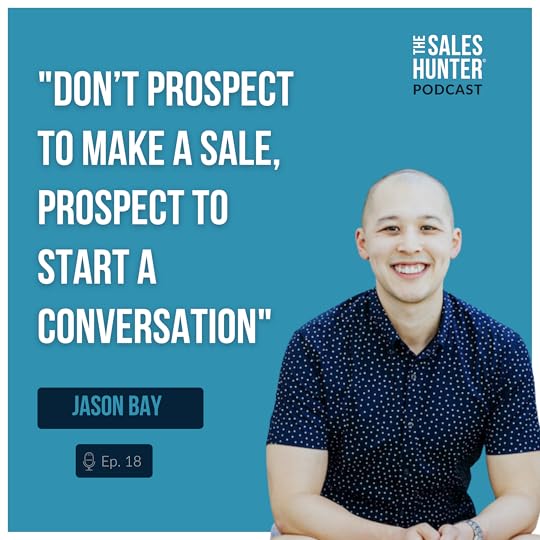 Episode 183 Steps to Make Outbound Easier
Episode 183 Steps to Make Outbound EasierA cold call is not a mini-sales call. Jason Bay teaches how we can warm it up into a conversation between peers.
What insights could you share that would make their time worth it even if they don’t move forward with you?
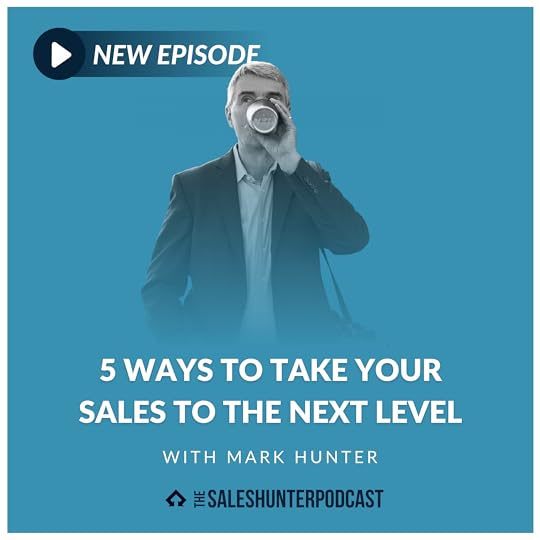 Episode 115 Ways to Take Your Sales to the Next Level
Episode 115 Ways to Take Your Sales to the Next LevelMark dives into why we sell, and how to find a powerful why.
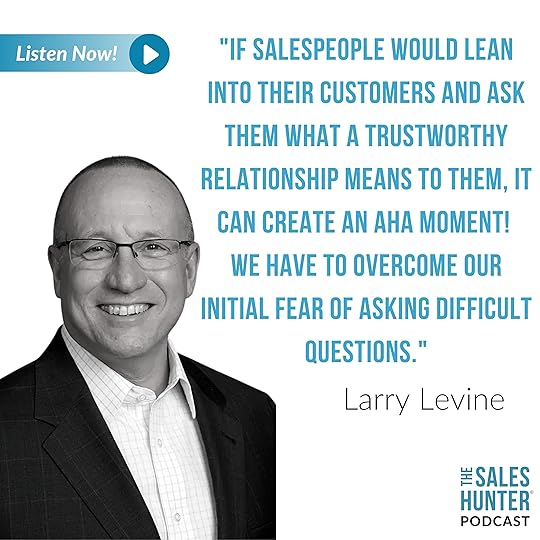 Episode 26How Salespeople Can Build Trust and Close Deals
Episode 26How Salespeople Can Build Trust and Close DealsLarry Levine shares how to work discussions of trust into our conversations with customers by leaning in and getting to know them.
Larry and Mark share how it is possible, and discuss the non-negotiables great salespeople (and human beings) simply aren’t willing to sacrifice to make a deal.
 Episode 34What Mindset Separates Average from a Top Performer?
Episode 34What Mindset Separates Average from a Top Performer?We all have our strengths and our weaknesses. Donald Kelly, The Sales Evangelist, shows how mindset is often what separates top performers from the pack of average.
 Episode 35How High Performers Overcome Indecision
Episode 35How High Performers Overcome IndecisionMost salespeople meet customer indecision with fanfare of ROI data; why their solution is better, faster, or cheaper—maybe even fake urgency.
Matt Dixon shares how these tactics are statistically proven to work against us… and only deepen a customer’s indecisiveness.
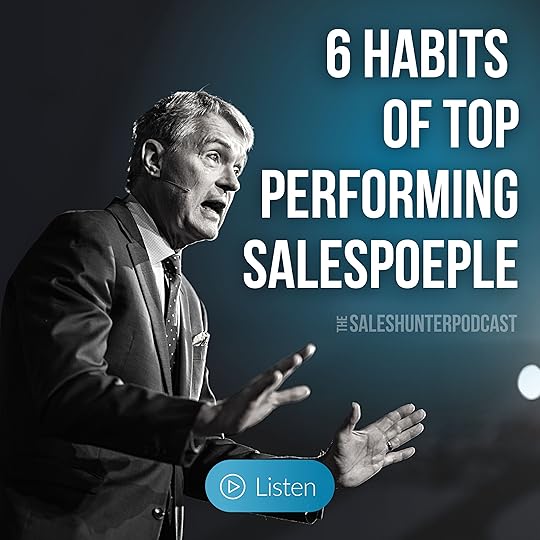 Episode 37 6 Habits of Top Performing Salespeople
Episode 37 6 Habits of Top Performing Salespeople
Success in sales isn’t all about the product you sell, or the customers you have. It starts with you.
 Episode 52How Top Salespeople Prepare for the Day, Then Conquer It
Episode 52How Top Salespeople Prepare for the Day, Then Conquer ItWhat are your non-negotiables today? Is everything on your to-do list mission critical?
Carson Heady shares how to use every resource at your disposal to show up, invest in relationships, and create value.
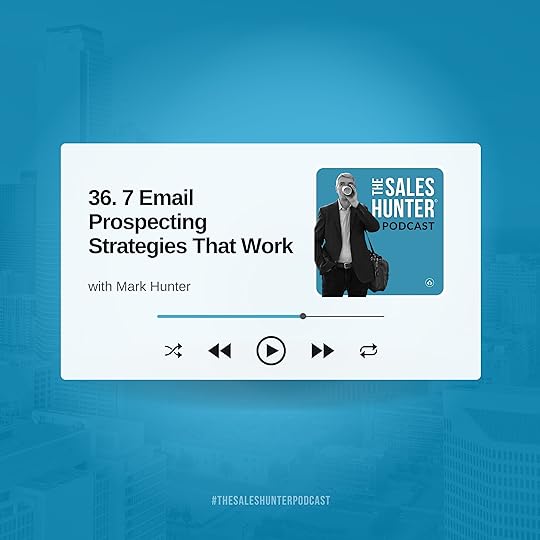 Episode 36 7 Email Prospecting Strategies that Work
Episode 36 7 Email Prospecting Strategies that Work
Let’s improve the content of your email, as well as the response rate.
You don’t want emails that just get opened, you want them to start a conversation–and lead to a sale!
 Episode 62 Unlocking Success on LinkedIn
Episode 62 Unlocking Success on LinkedInCould your social media habits be sabotaging your ability to reach people on LinkedIn?
Richard Bliss shares practical ways to make your activity on LinkedIn effective and reach a wider audience
 Thank you to our listeners, and to each of our 43 guests who brought such valuable insights to the show.Cheers to Year #2!
Thank you to our listeners, and to each of our 43 guests who brought such valuable insights to the show.Cheers to Year #2!
Subscribe to The Sales Hunter Podcast wherever you stream podcasts.
Leave us a review! It helps us continue to grow.
 Choose a sales skill to improve this month, Mark has a masterclass for them all! What will it be?
Choose a sales skill to improve this month, Mark has a masterclass for them all! What will it be?Get them all + many more when you become an All Access Member.
Copyright 2023, Mark Hunter “The Sales Hunter” Sales Motivation Blog. Mark Hunter is the author of A Mind for Sales and High-Profit Prospecting: Powerful Strategies to Find the Best Leads and Drive Breakthrough Sales Results .
The post The Top 10 Episodes for The Sales Hunter Podcast first appeared on The Sales Hunter.
Mark Hunter's Blog
- Mark Hunter's profile
- 25 followers



